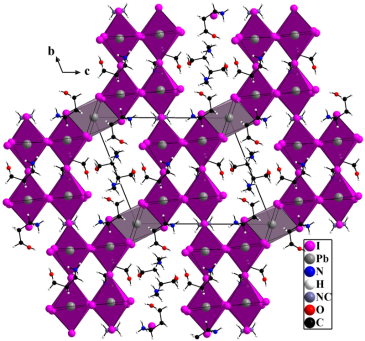- Index
- >Laboratoire Moltech-Anjou
- >Publications
- >Publi. CIMI - Crystals, dec. 2021
Publication CIMI - Crystals, dec. 2021
Le 16 décembre 2021
Nouvel article de l'équipe CIMI dans Crystals:
A 3D Lead Iodide Hybrid Based on a 2D Perovskite Subnetwork.
Maroua Ben Haj Salah, Justine Tessier, Nicolas Mercier, Magali Allain, Antonin Leblanc, Xiaoyang Che, Claudine Katan and Mikael Kepenekian
Abstract
 Lead halide perovskites have emerged as promising materials for various optoelectronic applications. For photovoltaics, the reference compound is the 3D perovskite (MA)PbI3 (MA+ = methylammonium). However, this material suffers from instabilities towards humidity or light. This makes the search of new stable 3D lead halide materials very relevant. A strategy is the use of intermediate size cations instead of MA, which are not suitable to form the 3D ABX3 perovskites or 2D perovskites. Here, we report on a novel 3D metal halide hybrid material based on the intermediate size cation hydroxypropylammonium (HPA+), (HPA)6(MA)Pb5I17. We will see that extending the carbon chain length from two CH2 units (in the hydroxylethylammonium cation, HEA+) to three (HPA+) precludes the formation of a perovskite network as found in the lead and iodide deficient perovskite (HEA,MA)1+xPbxI3−x. In (HPA)6(MA)Pb5I17 the 3D lead halide network results from a 2D perovskite subnetworks linked by a PbI6 octahedra sharing its faces. DFT calculations confirm the direct band gap and reveal the peculiar band structure of this 3D network. On one hand the valence band has a 1D nature involving the p orbitals of the halide. On the other, the conduction band possesses a clear 2D character involving hybridization between the p orbitals of the metal and the halide.
Lead halide perovskites have emerged as promising materials for various optoelectronic applications. For photovoltaics, the reference compound is the 3D perovskite (MA)PbI3 (MA+ = methylammonium). However, this material suffers from instabilities towards humidity or light. This makes the search of new stable 3D lead halide materials very relevant. A strategy is the use of intermediate size cations instead of MA, which are not suitable to form the 3D ABX3 perovskites or 2D perovskites. Here, we report on a novel 3D metal halide hybrid material based on the intermediate size cation hydroxypropylammonium (HPA+), (HPA)6(MA)Pb5I17. We will see that extending the carbon chain length from two CH2 units (in the hydroxylethylammonium cation, HEA+) to three (HPA+) precludes the formation of a perovskite network as found in the lead and iodide deficient perovskite (HEA,MA)1+xPbxI3−x. In (HPA)6(MA)Pb5I17 the 3D lead halide network results from a 2D perovskite subnetworks linked by a PbI6 octahedra sharing its faces. DFT calculations confirm the direct band gap and reveal the peculiar band structure of this 3D network. On one hand the valence band has a 1D nature involving the p orbitals of the halide. On the other, the conduction band possesses a clear 2D character involving hybridization between the p orbitals of the metal and the halide.


